

|
| DEUTSCHLAND | GERMANY |
| Bundesland: Freie Hansestadt Bremen | |
| Stadt: Bremen |
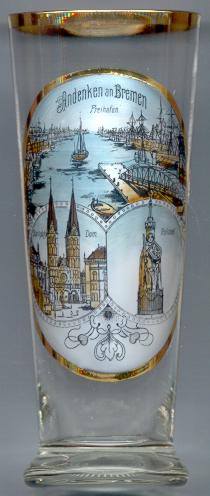 Bremen is situated at an elevation of 11 m on the river Weser. Bremen is the capital of Germany's state
Freie Hansestadt Bremen, which consists of the city of Bremen and the city of Bremerhaven,
about 60 km north of Bremen. The overseas port of Bremerhaven is also part of the city of Bremen, but is
administered by Bremerhaven. Bremen has a population of about 547,300 (2005).
Bremen is situated at an elevation of 11 m on the river Weser. Bremen is the capital of Germany's state
Freie Hansestadt Bremen, which consists of the city of Bremen and the city of Bremerhaven,
about 60 km north of Bremen. The overseas port of Bremerhaven is also part of the city of Bremen, but is
administered by Bremerhaven. Bremen has a population of about 547,300 (2005).
In the 8th century the troops of Charlemagne advanced to the Weser in order to christianise the tribes settling here. Bremen, which may have been an older settlement, became a bishopric. A deed claiming the town's foundation in 788 has now been recognised as a forgery, so the exact date is unknown. In the 12th century the power of the archbishops was challenged by Heinrich the Lion, Duke of Saxony and Bavaria. Heinrich was successful and became the factual ruler of the town. Bremen became a merchants' town, and its ships dominated the southern portions of the North Sea. This dominance ended when the Hanseatic League, originally a trade alliance of the Baltic Sea only, expanded to the North Sea. In the early 14th century ships from Bremen acted as pirates to board Hanseatic cogs. In order to avoid open war aldermen from Bremen went to the Hanseatic Council in Lübeck and in 1358 agreed to becoming members of the league. Bremen remained a reluctant member of the Hanseatic League and was eventually expelled from the league in 1427. The sudden loss of power led to territorial claims of neighbouring states, such as Oldenburg, and significant territorial losses.
After World War II, Bremen became a part of the American occupation zone since the USA wanted to have one port town
within their zone (see map). This prevented the inclusion of Bremen into the new Land of
Lower Saxony that was formed around it within the British zone, and secured Bremen independence as a Federal State of its
own right in the new West German federation.
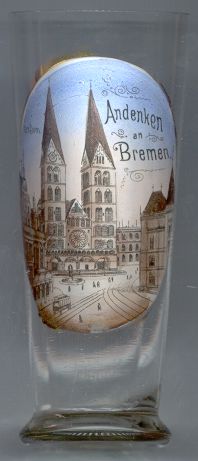
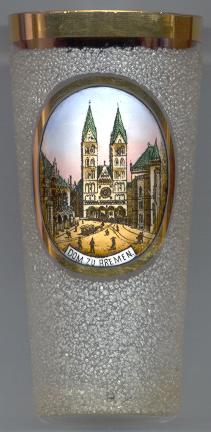
The  Dom Sankt Petri was built between the 11th and 13th century.
Several chapels were added to the nave in the 14th century, the Northern parts were remodeled in late Gothic style
in the late 16th century.
Dom Sankt Petri was built between the 11th and 13th century.
Several chapels were added to the nave in the 14th century, the Northern parts were remodeled in late Gothic style
in the late 16th century.
The bishopric was founded by Willehad, a missionary from Northumbria. He became the first bishop of Bremen and founded the first cathedral, a wooden construction, in AD 789. In 1223 the title of archbishops was transfered to Bremen from Hamburg. In 1522, the Reformation was introduced in Bremen. Between 1561 and 1638 the cathedral was closed and was the reopened for the Lutheran community of Bremen. The diocese ceased to exist in 1648.
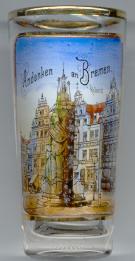
The  Roland [near left, no. 866],
a medieval symbol of the independence of the city,
is one the most popular landmarks of Bremen.
The stone statue has a height of 5.5 metres and stands on a low pedestal. At its back side, a pillar carries a
canopy. The total height is 10.2 metres. The statue was created in 1404 and replaced an earlier, wooden Roland,
which had been destroyed in 1366.
Roland [near left, no. 866],
a medieval symbol of the independence of the city,
is one the most popular landmarks of Bremen.
The stone statue has a height of 5.5 metres and stands on a low pedestal. At its back side, a pillar carries a
canopy. The total height is 10.2 metres. The statue was created in 1404 and replaced an earlier, wooden Roland,
which had been destroyed in 1366.
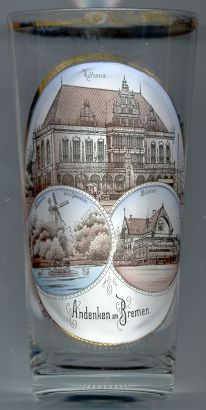
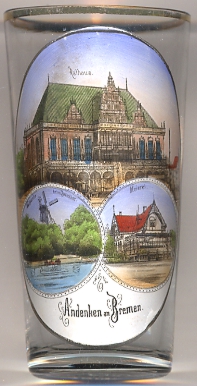
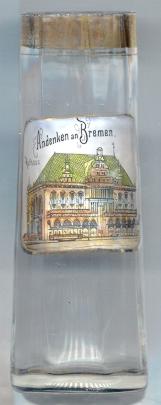
The  town hall [left, nos.1431 and 2878: top pictures, and right, no. 944]
i sone of the most important Gothic buildings in Germany. The old town hall had been built in 1405–1409.
In 1595–1612 the building was renovated and received its splendid Renaissance façade. An annex in Renaissance
revival style was added to its back side in 1909–1913.
town hall [left, nos.1431 and 2878: top pictures, and right, no. 944]
i sone of the most important Gothic buildings in Germany. The old town hall had been built in 1405–1409.
In 1595–1612 the building was renovated and received its splendid Renaissance façade. An annex in Renaissance
revival style was added to its back side in 1909–1913.
Secured by protective constructions both the town hall and the Roland survived the bombings of Bremen during World War II and were listed in 2004 by UNESCO as a World Cultural Heritage site (see also list of other UNESCO heritage sites).
The  windmill at the Wall [left, nos. 1431 and 2878: bottom left pictures]
also is a popular landmark of the city. It is one of 5 windmills in the town that have stood the times. The windmill
operated until 1950.
windmill at the Wall [left, nos. 1431 and 2878: bottom left pictures]
also is a popular landmark of the city. It is one of 5 windmills in the town that have stood the times. The windmill
operated until 1950.
The  Meierei ('dairy-farm') in Bürgerpark [left, nos. 1431 and 2787: bottom right pictures]
was opened in 1881. The construction in 'Swiss' style operates as a restaurant.
Meierei ('dairy-farm') in Bürgerpark [left, nos. 1431 and 2787: bottom right pictures]
was opened in 1881. The construction in 'Swiss' style operates as a restaurant.
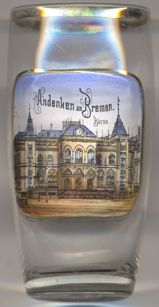
The  Neue Börse (New Stock Exchange) [left, no. 3982]
was built in 1861–1864 on the eastern side of the market square.
The New Exchange was a large Neo-gothic building with two towers and a front staircase). The interior was decorated by many of the most well-known artists
of the time. The building included a great hall, several counting rooms, a meeting room, and offices, which were also used by the Bürgerschaft of Bremen.
In addition there was a restaurant in the basement, which is still in operation.
In the course of the November Revolution of 1918, the New Exchange was briefly in the political spotlight when the politician Alfred Henke announced the
seizure of power by a Worker's council and the dissolution of the Bremen Senate and Bürgerschaft in a hall of the building, marking the beginning of
the short-lived Bremen Civic Republic. In 1934 the New Exchange was closed and the civic trade in securities was transferred to the Hanseatic Exchange in
Hamburg.
Neue Börse (New Stock Exchange) [left, no. 3982]
was built in 1861–1864 on the eastern side of the market square.
The New Exchange was a large Neo-gothic building with two towers and a front staircase). The interior was decorated by many of the most well-known artists
of the time. The building included a great hall, several counting rooms, a meeting room, and offices, which were also used by the Bürgerschaft of Bremen.
In addition there was a restaurant in the basement, which is still in operation.
In the course of the November Revolution of 1918, the New Exchange was briefly in the political spotlight when the politician Alfred Henke announced the
seizure of power by a Worker's council and the dissolution of the Bremen Senate and Bürgerschaft in a hall of the building, marking the beginning of
the short-lived Bremen Civic Republic. In 1934 the New Exchange was closed and the civic trade in securities was transferred to the Hanseatic Exchange in
Hamburg.
[https://de.wikipedia.org/wiki/Bremer_B%C3%B6rse, https://de.wikipedia.org/wiki/Bremer_B%C3%B6rse]
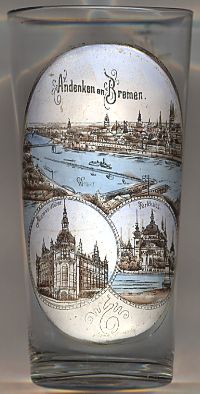
The  Baumwollbörse (Cotton Exchange) [near left, no. 2554: bottom left picture]
was founded in 1872 as Komité für den Baumwollhandel (Committee for Cotton Trade) and obtained legal capacity in 1889.
The building depictedon glass no. 2554 was built in 1900–1902 by the Bremen architect Johann Georg Poppe.
The back part of the building was destroyed during World War , the spire was torn down after the war and at the same time
the stucco decorations were removed. In place of the former back part of the building a multi-storey car park was
built in 1961. Parts of the car park were rebuilt in 2002 to become an office building.
Baumwollbörse (Cotton Exchange) [near left, no. 2554: bottom left picture]
was founded in 1872 as Komité für den Baumwollhandel (Committee for Cotton Trade) and obtained legal capacity in 1889.
The building depictedon glass no. 2554 was built in 1900–1902 by the Bremen architect Johann Georg Poppe.
The back part of the building was destroyed during World War , the spire was torn down after the war and at the same time
the stucco decorations were removed. In place of the former back part of the building a multi-storey car park was
built in 1961. Parts of the car park were rebuilt in 2002 to become an office building.


The old  Parkhaus in Bürgerpark [left, no. 1114, and right, no. 2182: top picture]
was built in 1890 on the occasion of the "Nordwestdeutsche Gewerbe- und Industrieausstellung" (Northwest German Trade and
Industry Exhibition). It incorporated parts of the earlier Parkhaus built in 1872/1874. The concert hall alone had a
capacity of 3,500 seats. In 1907 the building was completely destroyed by a fire.
Parkhaus in Bürgerpark [left, no. 1114, and right, no. 2182: top picture]
was built in 1890 on the occasion of the "Nordwestdeutsche Gewerbe- und Industrieausstellung" (Northwest German Trade and
Industry Exhibition). It incorporated parts of the earlier Parkhaus built in 1872/1874. The concert hall alone had a
capacity of 3,500 seats. In 1907 the building was completely destroyed by a fire.
The  Meierei [right, no. 2182: bottom left picture] was built in 1881.
The dairy farm in Bürgerpark included a stable for 36 cows (alter also one for swine), a cheese dairy and a restaurant.
As an additional attraction a cage for monkeys was added in 1886. The stables were closed in 1900 and the dairy farm also
was shut down soon after. The restaurant, however, continued its business. As the building was not destroyed in World War II,
the Meierei continues to be a popular attraction in Bürgerpark.
Meierei [right, no. 2182: bottom left picture] was built in 1881.
The dairy farm in Bürgerpark included a stable for 36 cows (alter also one for swine), a cheese dairy and a restaurant.
As an additional attraction a cage for monkeys was added in 1886. The stables were closed in 1900 and the dairy farm also
was shut down soon after. The restaurant, however, continued its business. As the building was not destroyed in World War II,
the Meierei continues to be a popular attraction in Bürgerpark.
The  Café at the lake, Emmasee, [right, no. 2182: bottom rightpicture]
was built in the then popular 'Tyrolean' style in 1897. In 1908 a music pavillon was added.
The café was destroyed in 1945. A modern café was built in its place in 1964.
Café at the lake, Emmasee, [right, no. 2182: bottom rightpicture]
was built in the then popular 'Tyrolean' style in 1897. In 1908 a music pavillon was added.
The café was destroyed in 1945. A modern café was built in its place in 1964.
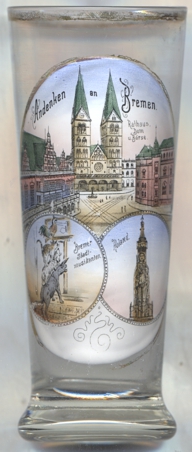
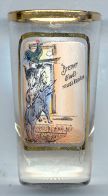
Glass no. 1750 [near left] and the bottom left picture on glass no. 4341 [far left]
depict the four characters from the popular fairy tale
Die Bremer Stadtmusikanten (The Town Musicians of Bremen), recorded in 1812–1837 by Jakob and Wilhelm Grimm.
In the story a donkey, a dog, a cat and a rooster, all mistreated by their masters, leave them and meet in a desolate place.
They decide to go to Bremen, known for its freedom, to live without owners.
Bremen remembers the tale with a two metre high bronze statue, created by Gerhard Marcks in 1953, near the city hall.
The line "…etwas Besseres als den Tod findest du überall…" ('something better than death you'll find anywhere') was
taken up by Carl Zuckmayer in his tragicomedy Der Hauptmann von Köpenick).
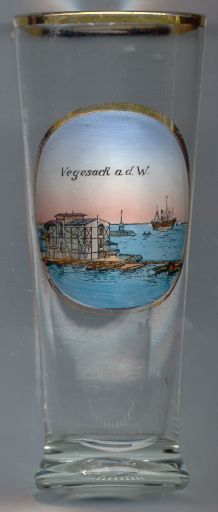
[http://en.wikipedia.org/wiki/Bremen_(city), http://en.wikipedia.org/wiki/Bremen-Vegesack,
http://en.wikipedia.org/wiki/Town_Musicians_of_Bremen]
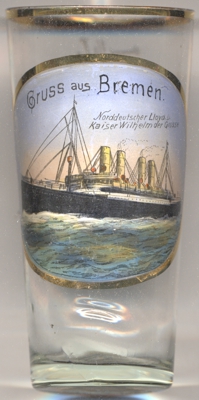
The  Kaiser Wilhelm der Große of the Norddeutscher Lloyd (NDL) company [left, no. 4229]
was built at the Vulcan shipyards in Stettin (now Szczecin, Poland) and entered service in 1897. It was named after
Wilhelm I, the first emperor of the German Empire. It was the first liner to have four funnels and is considered to be the first "superliner".
The first of four sister ships built between 1903 and 1907 by NDL (the others being Kronprinz Wilhelm, Kaiser Wilhelm II and
Kronprinzessin Cecilie; see Bremerhaven), she marked the beginning of a change in the way maritime supremacy was
demonstrated in Europe at the beginning of the 20th century. Quickly established on the Atlantic, she gained the Blue Riband for Germany, a notable
prize for the fastest trip from Europe to America which had been previously dominated by the British. In 1900, she was damaged in a massive and lethal
multi-ship fire in the port of New York. She was also in a collision in the French port of Cherbourg in 1906. With the advent of
her sister ships, she was modified to an all-third-class ship to take advantage of the lucrative immigrant market travelling to the United States.
Converted into an auxiliary cruiser at the outbreak of World War I, she was given orders to capture and destroy enemy ships. She destroyed several
before being defeated in the Battle of Río de Oro by the British cruiser HMS Highflyer and scuttled by her crew, just three weeks after the outbreak
of war. Her wreck was discovered in 1952 and partly dismantled.
Kaiser Wilhelm der Große of the Norddeutscher Lloyd (NDL) company [left, no. 4229]
was built at the Vulcan shipyards in Stettin (now Szczecin, Poland) and entered service in 1897. It was named after
Wilhelm I, the first emperor of the German Empire. It was the first liner to have four funnels and is considered to be the first "superliner".
The first of four sister ships built between 1903 and 1907 by NDL (the others being Kronprinz Wilhelm, Kaiser Wilhelm II and
Kronprinzessin Cecilie; see Bremerhaven), she marked the beginning of a change in the way maritime supremacy was
demonstrated in Europe at the beginning of the 20th century. Quickly established on the Atlantic, she gained the Blue Riband for Germany, a notable
prize for the fastest trip from Europe to America which had been previously dominated by the British. In 1900, she was damaged in a massive and lethal
multi-ship fire in the port of New York. She was also in a collision in the French port of Cherbourg in 1906. With the advent of
her sister ships, she was modified to an all-third-class ship to take advantage of the lucrative immigrant market travelling to the United States.
Converted into an auxiliary cruiser at the outbreak of World War I, she was given orders to capture and destroy enemy ships. She destroyed several
before being defeated in the Battle of Río de Oro by the British cruiser HMS Highflyer and scuttled by her crew, just three weeks after the outbreak
of war. Her wreck was discovered in 1952 and partly dismantled.
Several glasses of this collection show other ships.
[https://en.wikipedia.org/wiki/SS_Kaiser_Wilhelm_der_Grosse]
![[scale]](lineal.jpg)